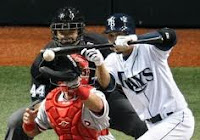With the previous entry we described the "Dropped Third Strike". As promised, this one will talk about the Infield Fly Rule. Right off the bat (no pun intended) we'll give you an excerpt from the rules book. Rule 2.00 Definition of Terms:
An
INFIELD FLY is a fair fly ball (not including a line drive nor an attempted
bunt)
which can be caught by an infielder with ordinary effort, when first and
second, or
first,
second and third bases are occupied, before two are out. The pitcher, catcher
and any
outfielder
who stations himself in the infield on the play shall be considered infielders
for
the purpose of this rule.
The Infield Fly rule kicks in with less than two outs and runners on first and second or the bases loaded. When a fly ball in the infield is deemed catch-able by the umpire he signals "Infield Fly" and the rule comes into effect. The batter is automatically out regardless if the ball is caught or not. Once again this seems a little silly until we look at a scenario. Let's pretend the infield fly rule does not exist. With a runner on first and second and no outs, the batter hits a high fly to the shortstop. The runners on first and second must stay put on their bases or risk being doubled up. The shortstop purposely drops the ball throws to the third baseman who is covering third then the third baseman throws to second for a double play. Doesn't seem fair does it? Of course not! That's why the powers that be implemented the Infield Fly Rule.
Below is how to score a Infield Fly. I put in the first two batters to show the base runners.
Below is how to score a Infield Fly. I put in the first two batters to show the base runners.
There you have it. Simple enough right? Next post we'll talk about Kenesaw Mountain Landis. Who? ... Where? He's a "who" and you'll see what a fascinating person he is.
Thanks for reading,
-Tom
















